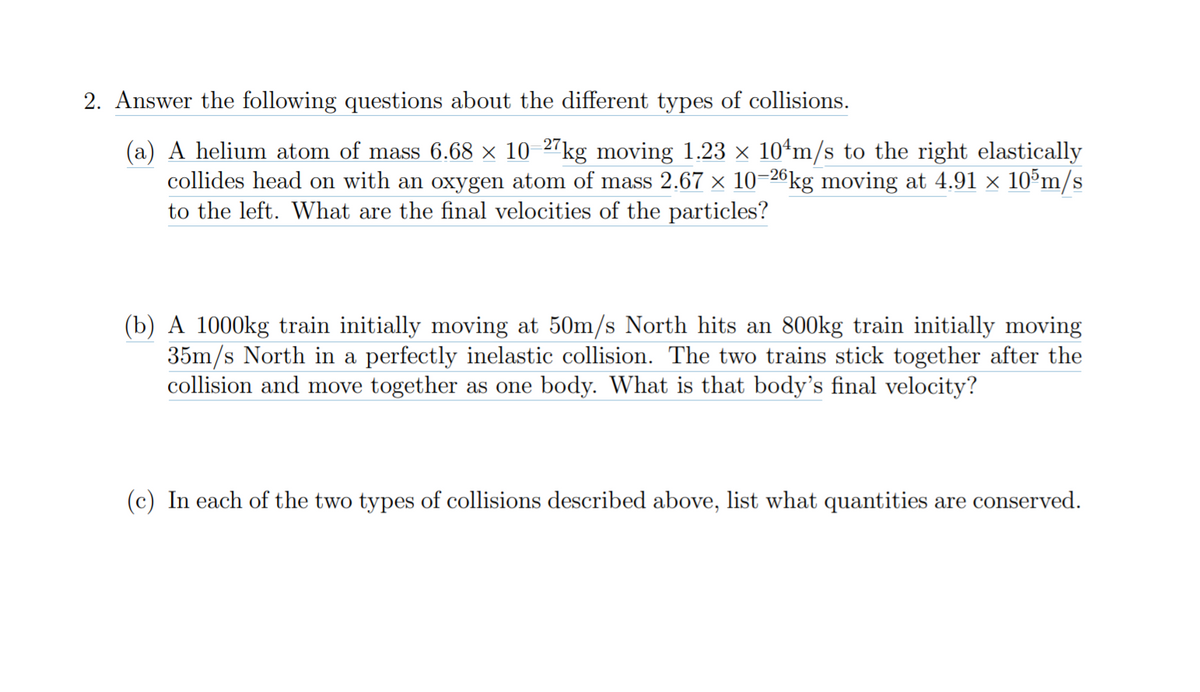2. Answer the following questions about the different types of collisions. (a) A helium atom of mass 6.68 × 10 27kg moving 1.23 × 104m/s to the right elastically collides head on with an oxygen atom of mass 2.67 x 10-26kg moving at 4.91 × 10ºm/s to the left. What are the final velocities of the particles? (b) A 1000kg train initially moving at 50m/s North hits an 800kg train initially moving 35m/s North in a perfectly inelastic collision. The two trains stick together after the collision and move together as one body. What is that body's final velocity? (c) In each of the two types of collisions described above, list what quantities are conserved.
2. Answer the following questions about the different types of collisions. (a) A helium atom of mass 6.68 × 10 27kg moving 1.23 × 104m/s to the right elastically collides head on with an oxygen atom of mass 2.67 x 10-26kg moving at 4.91 × 10ºm/s to the left. What are the final velocities of the particles? (b) A 1000kg train initially moving at 50m/s North hits an 800kg train initially moving 35m/s North in a perfectly inelastic collision. The two trains stick together after the collision and move together as one body. What is that body's final velocity? (c) In each of the two types of collisions described above, list what quantities are conserved.
Physics for Scientists and Engineers, Technology Update (No access codes included)
9th Edition
ISBN:9781305116399
Author:Raymond A. Serway, John W. Jewett
Publisher:Raymond A. Serway, John W. Jewett
Chapter9: Linear Momentum And Collisions
Section: Chapter Questions
Problem 9.44P: The mass of the blue puck in Figure P9.44 is 20.0% greater than the mass of the green puck. Before...
Related questions
Question

Transcribed Image Text:2. Answer the following questions about the different types of collisions.
(a) A helium atom of mass 6.68 × 10-27kg moving 1.23 x 104ʻm/s to the right elastically
collides head on with an oxygen atom of mass 2.67 x 10-26kg moving at 4.91 × 10°m/s
to the left. What are the final velocities of the particles?
(b) A 1000kg train initially moving at 50m/s North hits an 800kg train initially moving
35m/s North in a perfectly inelastic collision. The two trains stick together after the
collision and move together as one body. What is that body's final velocity?
(c) In each of the two types of collisions described above, list what quantities are conserved.
Expert Solution
This question has been solved!
Explore an expertly crafted, step-by-step solution for a thorough understanding of key concepts.
This is a popular solution!
Trending now
This is a popular solution!
Step by step
Solved in 3 steps

Recommended textbooks for you

Physics for Scientists and Engineers, Technology …
Physics
ISBN:
9781305116399
Author:
Raymond A. Serway, John W. Jewett
Publisher:
Cengage Learning

College Physics
Physics
ISBN:
9781938168000
Author:
Paul Peter Urone, Roger Hinrichs
Publisher:
OpenStax College

College Physics
Physics
ISBN:
9781285737027
Author:
Raymond A. Serway, Chris Vuille
Publisher:
Cengage Learning

Physics for Scientists and Engineers, Technology …
Physics
ISBN:
9781305116399
Author:
Raymond A. Serway, John W. Jewett
Publisher:
Cengage Learning

College Physics
Physics
ISBN:
9781938168000
Author:
Paul Peter Urone, Roger Hinrichs
Publisher:
OpenStax College

College Physics
Physics
ISBN:
9781285737027
Author:
Raymond A. Serway, Chris Vuille
Publisher:
Cengage Learning

Principles of Physics: A Calculus-Based Text
Physics
ISBN:
9781133104261
Author:
Raymond A. Serway, John W. Jewett
Publisher:
Cengage Learning

Classical Dynamics of Particles and Systems
Physics
ISBN:
9780534408961
Author:
Stephen T. Thornton, Jerry B. Marion
Publisher:
Cengage Learning

Physics for Scientists and Engineers: Foundations…
Physics
ISBN:
9781133939146
Author:
Katz, Debora M.
Publisher:
Cengage Learning